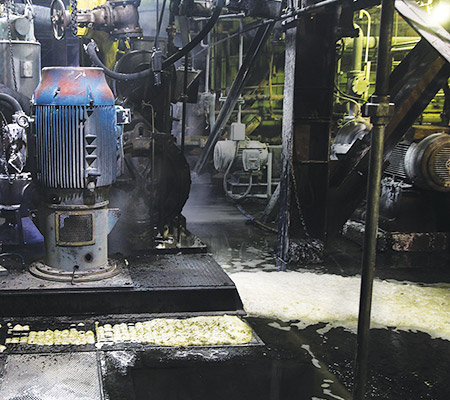Lube-Tips
The “Lube-Tips” section of Machinery Lubrication magazine feaTures innovaTive ideas submitted by our readers. additional tips can be found in our Lube-Tips email newsletter. if you have a tip to share, email it to admin@machinerylubricationindia.com. To receive the Lube-Tips newsletter, subscribe now at www.machineryLubricationindia.com/page/subscriptions.
 Tip for Pulling Representative Oil Samples
Tip for Pulling Representative Oil Samples
When working in an industrial plant where some or all of the equipment is open to the atmosphere (rain, mist, snow, etc.), wipe the moisture off your hard hat before taking or handling your sample. This is important even if the lube oil system is housed in an enclosed building. Walking from building to building, you can accumulate contaminant and moisture on your hard hat. All it takes is one unseen drop of moisture to contaminate your sample.
Avoid Overfilling gearboxes
Overflling a gearbox sump can be just as damaging as underflling. Overflling may cause air entrainment and foam, overheated oil and leakage due to overflow. Over time, oxidation may occur due to increased temperatures and exposure to air.
Extend the Life of Your Machine
Have you had a blood test lately? It is important to be aware of your physical condition, and a blood test can provide crucial information about your health. In a similar manner, oil analysis is just as important to equipment, because it analyzes not only the oil but the machine itself. This provides vital information to help determine the root cause of mechanical problems that threaten your machine. Utilizing oil analysis helps you get the most information, which can lead to success in asset management.
Advice for Summer Cooling System Maintenance
 Summertime heat can take its toll on cooling systems already taxed with engine operating temperatures at 225 to 250 degrees F. Today’s engines have a much tighter cooling margin than previous models. As a result, proper coolant and cooling system maintenance becomes increasingly important to maximizing system life and maintaining effciency.
Summertime heat can take its toll on cooling systems already taxed with engine operating temperatures at 225 to 250 degrees F. Today’s engines have a much tighter cooling margin than previous models. As a result, proper coolant and cooling system maintenance becomes increasingly important to maximizing system life and maintaining effciency.
Field testing performed with preventive maintenance (PM) is vital to maintaining an effcient cooling system and a coolant formulation that protects and prolongs system life. It ensures that system components are functioning properly, glycol levels are maintained at 50 to 60 percent for boiling-point control, inhibitor levels are maintained for proper metal protection, and the pH level is within the OEM’s and the coolant manufacturer’s specifcations for adequate corrosion control.
Just how important is coolant formulation and system effciency? A 50/50 coolant mix — 50 percent concentrate to 50 percent water — brings the coolant’s boiling point to 225 degrees F at sea level. That’s the low end for an engine today that operates at 225 to 250 degrees F. But every added pound of pressure raises that boiling point another 2.7 degrees F. So a 14-pound pressure cap raises the boiling point of a 50/50 formulation to about 263 degrees F. If a pressure cap or relief valve is defective or glycol levels are inadequate, the boiling point is right back down to the engine operating temperature.
A 40-degree buffer provides adequate protection against boiling. When conventional coolants are allowed to boil, glycol decomposition can cause several problems. The chemical reaction results in oxalic acid. This “burnt” coolant has a very distinctive dark brown/gold color and an even more distinctive odor. It creates a “varnish” that covers internal system components, prevents the system from operating properly and is extremely diffcult to correct. This varnish must be flushed, the system thoroughly cleaned and any hot spots corrected before new coolant can be introduced. Monitoring the system’s condition and strip-testing the coolant at every PM can keep operations running smoothly and without unexpected interruptions.
Further laboratory testing on a quarterly schedule can identify many issues caused by excessive heat before catastrophic failure occurs and assist maintenance management in determining appropriate preventive maintenance testing regimes.
